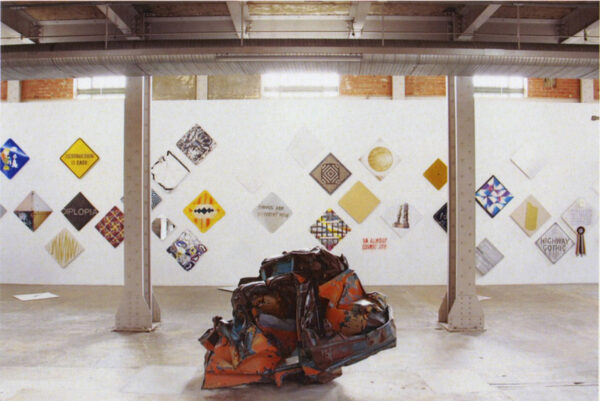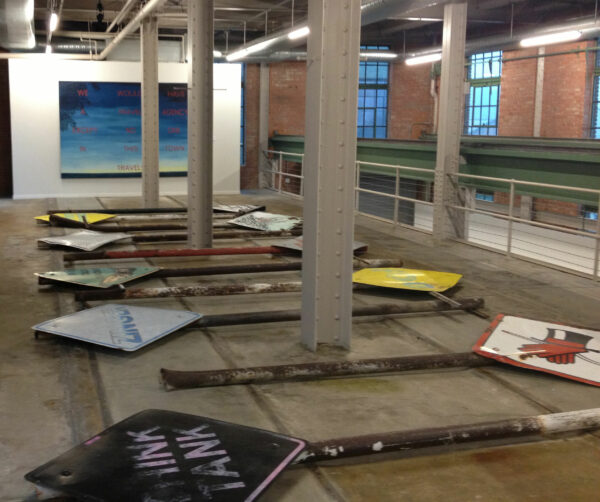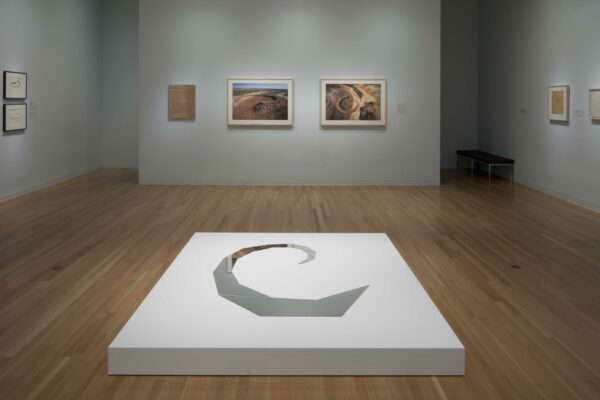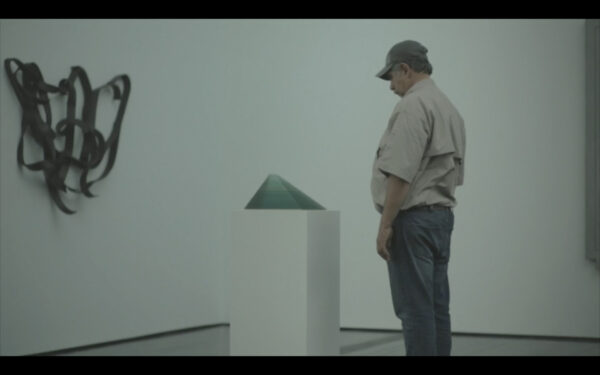Para leer este artículo en español, por favor vaya aquí. To read this article in Spanish, please go here.
The end of August marked the 50th anniversary of Amarillo Ramp, and no one cared. Robert Smithson designed the earthwork with an extended time scale in mind, so in the grand scheme of things, what is 50 years when one is thinking in millennia? Notably, an anniversary celebration appears insignificant to Smithson’s ethos, especially when intertwined with his untimely demise. Smithson died at age 35 on July 20, 1973 in a plane crash while surveying the site for Amarillo Ramp, which was completed posthumously the following month by fellow artists Richard Serra, who helped build Spiral Jetty, and Tony Shafrazi, who facilitated the visit to Amarillo, and Nancy Holt, his widow.
Amarillo Ramp is not a memorial. Although Smithson’s death inevitably cast a somber hue over the work, it remains distinct from his original intentions. His influence on the art world is as immense as his monumental rock and earth sculptures, yet these physical constructs merely scratch the surface of his legacy. The heaps of drawings and mounds of words he left behind exemplify his enduring potential. In the fortieth year since Amarillo Ramp’s creation, it became the linchpin connecting three projects that embody Smithson’s true artistic prowess: Amarillo Entropy at the Power Station, Mario García Torres’ film The Schlieren Plot, and Smithson in Texas at the Dallas Museum of Art. This milestone underscores the enduring resonance of Smithson’s creative vision, reminding us that his impact extends far beyond the boundaries of physical artworks.

Installation view of “Amarillo Entropy” at the Power Station in Dallas, with a “Non-Chamberlain” and sign works by Dallas and Amarillo artists, 2013. Photo: Greg Ruppe
Amarillo Entropy was on view in September 2013 at the Power Station in Dallas. The show featured contemporary works from Amarillo, and was a collaboration between Alden Pinnell, Gregory Ruppe, Matthew Williams, and myself, with Amarillo Ramp as the impetus for the exhibition. The title of the show is based on entropy, a leitmotif used by Smithson, and a measure of how much randomness or disorder exists in a system. To use a Smithsonian metaphor, think of a sandbox neatly divided into black and white halves of sand — a low-entropy scenario. After running in circles inside the sandbox, the two halves of the sand will inevitably mix, resulting in gray sand that becomes a high-entropy state which cannot be reversed. Smithson employed entropy as a lens to explore the irreversibility of time, a motif deeply embedded in his artistic expressions.
The world is a random place, and Amarillo Entropy expanded on this fact by making Amarillo Ramp a departure point to discuss the city’s unexpected art history. It highlighted art projects like Ant Farm’s Cadillac Ranch, the monument of partially buried cars that has now become a national icon. Ant Farm also pioneered video art, and Amarillo Entropy included their addition of “hippy commentary” to news reports at a local television station. This project was broadcasted live, as was Boomerang by Nancy Holt and Richard Serra, which was filmed at the same station. In the video, Holt wears a large pair of headphones that are feeding her voice back to her via a one-second delay as she tries to respond. Her phrasing begins to disintegrate, and her words become an abstract sculpture of language.
Amarillo’s entropy also affects Ed Ruscha, who included two photographs of Amarillo gas stations in his 1963 photoessay Twenty-six Gasoline Stations. One of these became the source for Ruscha’s painting from the same year, Standard Station, Amarillo, Texas, an image that has been reworked in many of his paintings and prints. Unfortunately, while we were not able to get one of these variations for the show, we did include a photograph of the original building — which is now a transmission shop — along with one of Ruscha’s paintings from Pinnell’s private collection.
John Chamberlain also spent several summers in Amarillo working on a series of his crushed car sculptures for his 1975 show at the Contemporary Arts Museum Houston; many of these works now live in Marfa. There was one Chamberlain left in Amarillo that we wanted, and tried to include in Amarillo Entropy. Through many attempts we decided the sculpture itself was uninterested, as it seemed to expand every time we tried to fit it inside a succession of larger and larger trucks. We ended up including a “Non-Chamberlain,” which came from Matthew Williams’ collection of the scrap car parts left unused by Chamberlain.

Installation view of the “Sign Project” in “Amarillo Entropy” at the Power Station in Dallas, 2013. Photo: Jon Revett
The surprise hit of the show was the Sign Project, done by the Dynamite Museum, the Amarillo collective of freaky artists where Matthew Williams and I met thirty years ago. In the mid-nineties, a series of yellow, diamond-shaped signs — the ones used for traffic signals and warning signs — started appearing in fields, vacant lots, and yards of homes around Amarillo. They were not normal signs, however, and their non-civic messages varied from simple phrases to lines from poetry and literature. Other signs held images with straightforward graphics to hand-painted portraits of Native Americans. Many signs have been removed since the end of the project, before the turn of the century. We brought sixteen of these “fallen soldiers” to the second floor of the Power Station and laid them on the floor as a visual nod to Walter DeMaria’s Broken Kilometer.
The sign format reoccured in Amarillo Entropy as a series by artists from Dallas and Amarillo. Each artist was asked to make a unique work using the diamond-shaped sign format, and the results were wildly varied. The “signs” were auctioned, and a portion of the proceeds went to fund restoration trips to Amarillo Ramp, initially under the direction of Nancy Holt. This action defines Amarillo Entropy. Art made in random places has just as much of an impact as work made in art centers. The show marked a place in time that allowed us to gauge the growth and expansion of art and our relationship to it. I still stay in touch with many of the artists from the show, some of whom have become major players in the Dallas scene. Williams continues to carry the torch in Amarillo by running Invisible Genie, one of the only contemporary spaces in town. Alden Pinnell and Greg Ruppe have maintained their ground-breaking programming at the Power Station, and Ruppe’s new project, Picnic Surf Shapes, was shown this summer at a gallery in New York City.
Mexico City-based conceptual artist Mario García Torres is known for reimagining preexisting artworks by other artists, one of which is Amarillo Ramp. In the summer of 2013, García Torres came to Amarillo to shoot The Schlieren Plot, his smart art version of a road trip movie. It follows a landscaper who sees Mirror Strata — Smithson’s stacked mirror sculpture — through a window at the Menil Collection in Houston. He then embarks on a journey across Texas. His first stop is in Dallas, and he stays at a hotel overlooking the DFW Airport, where he tries to visualize Smithson’s unrealized earthwork project intended for the airport. The protagonist continues north, and the film culminates as he abandons his car to walk out to Amarillo Ramp. The final scene of the film is an aerial shot that rises from the earthwork itself and flows from its site in the deserted Canadian River breaks towards the city, like a time-lapse of urban development: along a lone railroad track and dirt roads grow mobile homes, then thin lanes of pavement evolve into highways, neighborhoods, and buildings.
When García Torres and his crew arrived in Amarillo, thunderstorms were putting on lightning shows in the distant horizon. We headed out to Amarillo Ramp, where we spent an inordinate amount of time filming parts of the narrative along with random things like dung beetles rolling balls of shit. Afterwards, I acted as location scout, finding uncanny locales around town to shoot different parts of the film, including a scene at the former Ruscha gas station.
They say if you don’t like the weather in Amarillo then wait five minutes; the inverse is also true. The monsoon season came to town the end of the second day, and it poured. The dirt roads leading to Amarillo Ramp became impassable mud troughs. We still had one shot left at the site, and debated renting horses to get out there. What had been a sequence of perfect blue-sky days turned to an unseasonably foggy morning, ruining the continuity of the film. The scene was quite surreal, which was reinforced when an airplane, parked in the middle of the road, materialized out of the mist. In the end we couldn’t do the last shoot because the crew had to return the next day to Mexico.
It is ironic when an artist known for finishing unfinished projects is unable to finish a project of his own, but García Torres is persistent. He is also brave. Despite my minimal film experience, García Torres mailed me a camera to go get that missing shot of the back side of Amarillo Ramp — the least dramatic angle to view the work — with a request to try to catch a mirage. I had no idea how to accomplish this feat, but in the finished version of the film, there was a shimmering visual distortion over my shot. García Torres added the secret star of the show in post — an optical inhomogeneity, known as schlieren, which cannot always be seen by the human eye — which revealed his movie is not about this scientific phenomenon, but about the unseen.
Like schlieren, the finished form of Amarillo Ramp was not seen by Smithson, but his ghost seemed to be present throughout the making of The Schlieren Plot. That airplane in the middle of the road became a reminder of what befell him. García Torres used a helicopter to get that closing aerial shot, but the sequence seemed like something Smithson would do in his own movies. Over the film, a disembodied voice also recites Smithson’s writings, and though the text is in Spanish, the voice narration is a common tool in Smithson’s filmmaking belt. The inclusion of these elements transforms The Schlieren Plot into an homage to the infinite potential of incomplete artworks not just by Robert Smithson, but all artists.

Installation view of the exhibition “Smithson in Texas,” curated by Leigh Arnold at the Dallas Museum of Art
In November of 2013, the Dallas Museum of Art opened Robert Smithson in Texas, an exhibition focused on the artist’s unfinished projects. Curated by Leigh Arnold, it explored the five art projects Smithson has proposed in the state, presenting drawings, sculptures, and photographs that illustrated their possible forms, and a video about the making of Amarillo Ramp, Smithson’s only completed work in the state. In a live interview for the Modern Art Notes podcast, Arnold talked with fellow curator Phyllis Tuchman, and the two delved into the profound influence of Texas’ expansive horizons on Smithson’s art. These immense spaces prompted him to transition from the confines of galleries to the openness of the outdoors, and Smithson in Texas validates this perspective.
The most ambitious possibility in the show is the proposal for the DFW International Airport, the same project the hero of The Schlieren Plot attempted to visualize. In 1966, an architect from the firm tasked with planning the DFW airport heard Smithson give a speech on aerial art at Yale and asked him to submit a proposal. It begins with, “Art today is no longer an architectural afterthought, or an object to attach to a building after it is finished, but rather a total engagement with the building process from the ground up and from the sky down.” The proposal then spirals into a pitch for four esoteric sculptures by Smithson and his contemporaries. Although the architecture firm was later removed from the project, Smithson had even more concepts for the airport, including a captivating drawing of meandering mounds of earth intertwined with gravel pathways, almost-prophetic renderings of airplane terminals.
The other three unfinished projects were plans for earthworks that preview Smithson’s outdoor interventions. Texas Overflow, my favorite of the trio, is a plan to pump hot asphalt into a limestone quarry at the Northwood Institute, a private college in Cedar Hill outside Dallas. This drawn mash-up of ooze and stone signals his interest in working with quarries and other damaged landscapes, while also demonstrating his advanced skill as a draftsman. Smithson continued to make proposals for art projects that reform industrial environmental scars, and this concept brought him back to Texas in 1973. He was researching reclamation art projects at the Colorado mines when he decided to visit Larry Bell at his studio in Taos, and it was there that he learned about an art-friendly rancher with an immense expanse of land outside Amarillo.
Amarillo Ramp was conceived, planned, and laid out within ten days of Smithson’s arrival in the Texas Panhandle. Smithson in Texas contained some of his preliminaries for this project, but the video of its construction was completed by Nancy Holt. Holt’s movie retains the construction equipment-as-dinosaurs aesthetic of his Spiral Jetty film, though a little clumsier. One of the trucks falls off the proto-Ramp and gets stuck in the muddy bed of drained Lake Tecovas. After the completion of Amarillo Ramp, the man-made lake refills, a setting which gave the Ramp its more iconic images; the water permanently disappeared when the damp broke a few years later. The sculpture now floats in a sea of mesquite trees, cacti, and buffalo grass, which rise and fall like flora tides.
These cycles of ebb and flow, growth and decay, and life and death surround Smithson’s work. Amarillo Ramp was his final work, and the video of its making is one of the last things Holt completed before she passed away in 2014. I had several conversations with her while I was co-authoring an essay for the catalog for Smithson in Texas. My colleague, Amy Von Lintel, built a proper academic article off my stream-of-conscious ramblings about my experiences with the earthwork. Holt gave us succinct edits that were vital in helping us prove our thesis that Amarillo Ramp was a true Smithson work, despite it being completed by other artists.
I may have been a tad dramatic by starting this essay saying that no one cares about the 50th anniversary of Amarillo Ramp. However, as the only person currently guiding the tours to the sculpture and its site, I can attest to the litany of people spending time and resources to come see it, despite the inherent logistical challenges. Every person I take there is not just impacted by the earthwork itself but by the entire experience. The sculpture itself appears abruptly after a long drive through the brush, populated by gas wells, cattle, and the occasional cowboy. For those not from Texas, it is a journey into the stereotyped visions of the state and the contradictions it can present. Amarillo Ramp is a time stamp for these visitors; its entropy becomes personal because they can only move forward from the experience of their visit.
When I look back ten years at the events surrounding Amarillo Ramp, the progress emanating from Robert Smithson’s work becomes crystal clear. Amarillo Entropy documented the expansion of art from a random place and is a marker for the growth of the artists and the expansion of scholarship around the artworks in the show. The Schlieren Plot may be a lesser-known work by Mario García Torres, but through its examination we can decipher his process and recognize the power of making the unseen seen. Robert Smithson in Texas explored the power of his unfinished works, amplifying those that were completed. This open-ended approach propels Smithson and all those influenced by him into the future.
Groundswell: Women of Land Art, Leigh Arnold’s latest curatorial effort, opens this fall at the Nasher Sculpture Center in Dallas. Her career has grown since Smithson in Texas, when she too formed a relationship with Nancy Holt, who is included in the upcoming exhibition. I do not want to taint this show with shades of Smithson, but rather illustrate the progress that it champions. I applaud Arnold for bringing these important artists their well-deserved and long-overdue attention. The history books have long championed Smithson as a pioneer of land art, and artists can either reject or accept his ideas, but they cannot deny his influence. I encourage everyone to attend the Groundswell symposium at the Nasher on September 23 and 24 to see how an important group of land artists have moved the medium forward. Unfortunately, I can’t be there; ironically, I will be painting a mural about Amarillo Ramp.






2 comments
Thank you for this informative overview of Amarillo Ramp and creative responses to it. Jon Revett has been a helpful guide to the Ramp for me and numerous other visitors. The narrative on how Robert Smithson’s Yale talk led him to proposals for art in the earth (beginning with between runways in the proposed DFW airport) is in my history “Earthworks: Art and the Landscape of the Sixties” (2002). The first account of Tony Shafrazi as Smithson’s connection to Stanley Marsh’s ranch outside of Amarillo, and the disguised mystical symbol embodied in the Ramp’s circularity, is in my “Inside the Spiral: The Passions of Robert Smithson” (2023), the first biography. It includes a stirring nocturnal photograph of the Ramp in water, 1976, by Austin photographer Wyatt McSpadden. Smithson is more fascinating than anyone — even I — imagined, for reasons until “Inside the Spiral” no one knew.
This is a great, informative and interesting article.